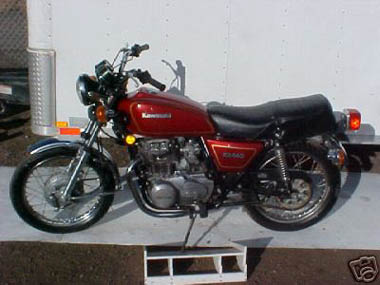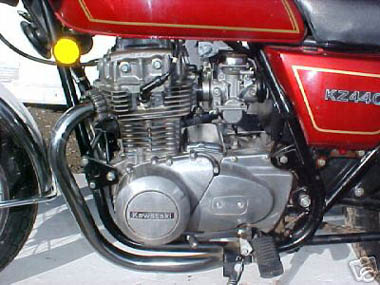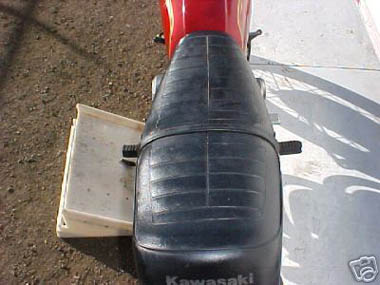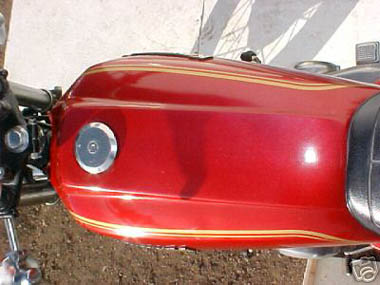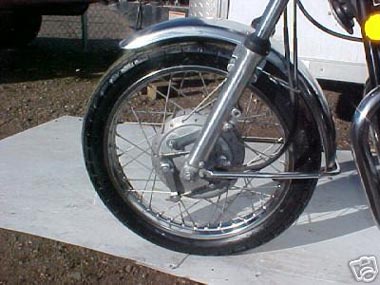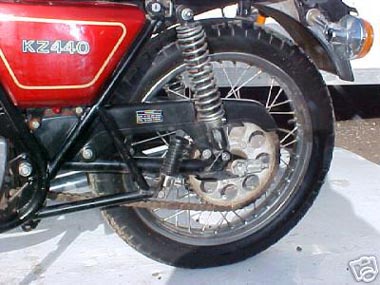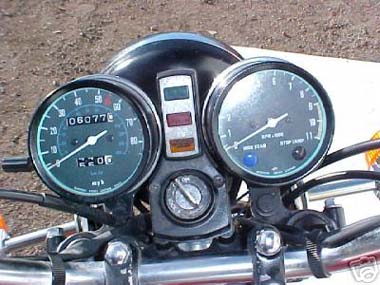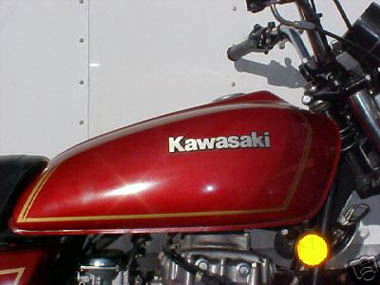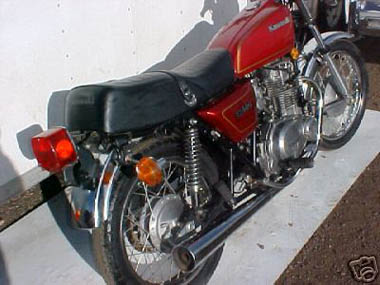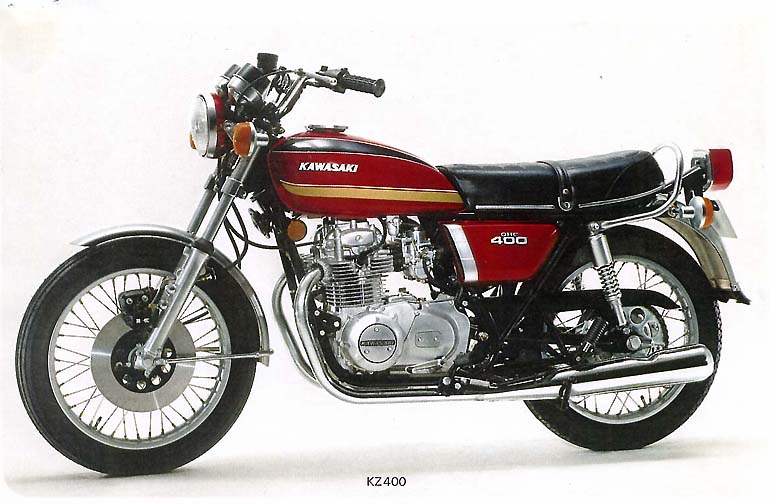
History

The beginning
Kawasaki Newsletter june 1974 (click on the images to enlarge)
How Kawasaki was marketing the first KZ400 (click to enlarge)
Having fun on a Z400
(The pictures above are published by the courtesy of Pete Johnson, Sheffield, England)
The first 13 models of the KZ/Z400, produced between 1974 and 1979.
KZ/Z440 Models
The written history
(The picture above is published by the courtesy of Pete Johnson, Sheffield, England)
The written history about the Z/KZ400 is not easy to come by. And when you study the books about classic Japanese motorcycles you will find very little written about it. Often only a comment about its existence. The KZ400 had a rather anonymous life trough its 10 years of production history that started in 1973, and ended in 1983. My guess, and that is a personal point of view, is that this was possible because of the bikes modest size and performance, and the fact that Kawasaki’s sales strategy was aimed against customers in the commuter market rather than the typical biker of the days. And it was not appealing to those who wanted a high performance bike. Through the years, when bikes in general got bigger and more powerful, the KZ400 was looked upon as a learner’s bike, and not a bike someone kept for years. They where cheap to buy, easy to maintain, and there was always another learner you could sell it on to when you went on to buy a bigger bike.
Today the situation is a bit different for the modest 400 . Now there are a strong growing interest in collecting and restoring Classic Japanese bikes all over the world. And the KZ400 are one of the models that both in looks and engine construction are getting more and more popular. It has got the classic look, and the engine is easy to rebuild and maintain, and the prices are so far modest compared with other classics. And since very few had any interest in tuning and modifying the KZ400 back in the 70's and 80's and very few tunig parts were available at the time, there are still a large number of running bikes that can be found. Also the spare part availability is better than for many bikes from the same era. And with the growing interest for Classic Japanese bikes there are a growing number of clubs, both national and international, for those who are collecting and riding those classics.
When the Z400 hit the UK market in 1975 one of the comments from a journalist was:" It is not going to jump out of the show room and sell it self". But the first UK road test printed in Motorcycle Sports in April 1975 described it as discreet, rather than dull. And they gave the bike a very positive mentioning as the "The little sister of the Z1". And they got impressed by the vibration free engine and the good handling and judged it to be one of the more interesting bikes of the period. But they did remark, as the US road tests also did, the mechanical noise at tick over. Quote:" It will certainly win no prizes for mechanical silence.
It got a much better reception in USA, several journalists made road tests, and the reviews were mostly positive. One of the first magazines to take on a road test was Cycle Guide in June 1974. They looked upon the bike as an alternative to the gas hungry polluting cars of the time, as a commuter. And that was what the bike was made for. It was launched under the oil crisis in the 70's, with increasing fuel prices and increasing environmental problems. And since the two stroke engines also was on their way into a blind alley because of the increased environment demands, the only option was to developed a new line of four stroke engine motorcycles, starting with the Z1 in 1972. And the KZ400 was Kawasaki’s effort to get in to the middleweight four stroke class, where Honda was in the lead with their CB350 and CB360. In fact, road testers often compared it with the Honda. One of the big differences was that Honda had chosen the 180 degree crank, while Kawasaki chooses to build an engine with a 360 degree crank, which was equipped with a dynamic balancer system, for smoothing out the vibrations that is unavoidable in a 360 degree parallell twin. And it did work, it was described as silk smooth, and in fact a properly tuned KZ400 engine is almost as smooth as an inline four from that era. The engine was described as surprisingly responsive and it pulled well all the way from 2500 rpm to its redline at 9500 rpm. And the fuel economy was very good. Only complaint about the engine was about oil leaks from the top end, a problem that followed the KZ400 up till they redesigned the cylinder head and cylinders for the 1978 model. Also the untensioned Hy-Vo primary chain was prone to rattle at idle on the early models. Not that there were a technical problem, but it was described as annoying.
On the road, the bike was very easy to manoeuvre and it handled well on twisty roads and at corners. It was very easy to ride in city traffic, and could also cope with the speed on the highways, despite its modest size. There where some remarks about the handling and comfort though. The suspension could have been better and the seat was to narrow for longer trips. But all in all the journalists was pleased with the bike.
In one road test published in February 1976 in USA, they even tried to break a bike down. They drove it down to Mexico, and in 100 degrees F, on two strait ways of 100 miles each, they drove the bike at full speed, and they never had the tacho needle fewer than 9000rpm. And the bike survived. Nothing broke. Engine performance did not change either. The only thing recorded was that the exhaust pipes turned violet and blue all the way to the lower bend, and a slight oil consume when ridden that hard at those temperatures. And on the whole trip they averaged 75-80mph, without any engine problems.
And in 1977 a team from Classic Mechanics made a 24 hour test at Snetterton raceway in England with a stock KZ400 and a stock KZ650, and both bikes made the test without any break downs.
One English test rider, John Nutting, made a summary of the KZ400 in Classic Motorcycle Mechanics in April 2003, where it was rated amongst the top 40 bikes of the seventies:
"Lasting impression often counts for a lot, and so it was for the unprepossessing Kawasaki 400 twin. It never aspired to offer great performance. Its looks would never make it stand out in a parking lot. It sounded like a car. But for solid dependability and the fit of a pair comfortable shoes, the KZ400 twin was a charmer. Its engine was a simple parallel twin with an overhead camshaft but twin balance shafts smoothed it out. Throttle response was so good from tick over to the 9000 rpm red line; you never needed to rev it. And every morning you'd fire it and it would be ready to go. Even city traffic became fun because the bike was so responsive and easy to use. And it was economical: up to 70 mpg without trying. More amazing was that it could reach 100 mph flat out. That's not boring".
And what about to day? Does the KZ400 still stand the test?
In the spring of 2002 the British MC- journalist Neil Murrey bought a 1979 KZ400 and used it as a commuter bike that summer. He also took it to a bike rally in Avac in France and to a Classic Road racing event at Chimay in Belgium during the summer. And he got impressed by its ability as a touring bike and described it as a extraordinarily pleasant machine at speeds up to 75 Mph. And he thought it was a delight to ride in city traffic speeds. Finally he judged it to have the same type of character as a Triumph twin, but without the vibrations.
Downsides
What about the downsides? Did it have any, and what where they? Yes there where downsides. The 1974 to 1977 had a top end oil leak that Kawasaki never managed to cure entirely, even if there were several solutions offered to the buyers. The most common was replacing all the oil seals and gaskets in the top end with a replacement kit that was made out of better material than the original seals. It did help, but did not cure the problem. The problem was not solved before the KZ400 B hit the market in 1978 with a redesigned top end, where the oil feed to the cylinder head was routed from the oil pump to the cylinder head with an external pipe.
As time went by also the balancer system revealed a weakness in the construction. As the chain became worn, the spring tensioned slipper blades did not cope with the wear and the chains sometimes jumped the sprocket and wore out the sprocket on the crankshaft and that called for a crankshaft replacement.
And like other Japanese bikes from the era there where some camshaft problems. The camshaft is running directly in the cylinder head without bearings and the camshaft could seize. That meant replacing the camshaft, the cylinder head and the cylinder head cover.
Also the carbs used from 1977 on the D4 model caused problems. The diaphragms would tear, resulting in poor running, and the diaphragms were, and still are, terrible expensive to replace.
And the damping was not the best. Replacing the rear shocks and installing a KX125 fork kit would make a great improvement.
There were also reports about main bearing and piston/cylinder wear problems on some of the early models.
Summing up
The KZ400 was never a performance bike. But it was not made to be. It was made as a commuter bike, and its performance was adequate for its purpose. It has got its downsides, just like many other bikes made in the 70's. But properly maintained, and with rigid oil and filter changes the reliability is pretty good. Trash it, and neglect the maintenance and oil changes, and it will wear down pretty fast. But that can be said about a lot of bikes. I know of well taken care of KZ400's with more than 60 000 miles on the clock. And there was a divergent view about the bike's reliability in England and USA that still exists today.
But since it was launched in 1974 and up till March 1st 1982 Kawasaki had sold 219 284 Z/KZ400's and 440's. Only the Z/KZ900/1000 was sold in a larger number. So something had to be right with the bike.
All in all I think it is a real classic that deserves to be taken care of, in spite of it's downsides. It is a part of the history of motorcycles.
And by now, I have been in contact with 400/440 owners from 45 different countries around the world. And they all ride and enjoy their bikes. And that might be the best prove of these bikes keeping quality.
Odd Ivar
Memories from the Kawasaki Plant in Lincoln Nebraska
By Paul Maseman
Note; please understand that these are thirty-year-old recollections! Some people saw these events from a different viewpoint and may not remember things the same way that I do.
I started working in the Kawasaki Motors Corp., USA plant in Lincoln, Nebraska, in November 1974, on the first day that it was opened to hourly workers. In the five years I worked there, my job progression was Frame Welder, Production Rework Technician, Process Engineering Technician, and Police Motorcycle Technical Representative. During my employment there from ’74 to ’79, they manufactured several variants of KZ400, KZ650, KZ900, KZ1000, and KDX-series motorcycles. In addition, Jet Skis and Snowmobiles were fabricated and assembled there.
Initially, an existing KZ400 production line at Akashi, Japan, was “cloned” in Lincoln. This involved replicating every part, process, and tool used on the Akashi line. The idea was to start KZ400 production in Lincoln using proven concepts. From the beginning, frames and fuel tanks were completely fabricated and welded in-house. Finished and pre-tested engine assemblies were imported from Japan. Wheels exhaust systems, forks, electrical parts, instruments and other parts were initially imported but later switched to US suppliers. It was an educational experience for some of the suppliers, many of whom supplied the Detroit auto industry, to adjust to the “just-in time” inventory requirements mandated by KMC. Initially, a couple of the Japanese Managers were very negative about the future success of the U.S. manufacturing endeavour and were not shy about expressing their opinions. Their reasoning was that American workers were obviously lazy and slow compared to Japanese workers and therefore the enterprise would surely fail. Within one year, we were producing KZ400s with 30% fewer man-hours per motorcycle than they were in Akashi! I can still remember one of the above-mentioned Managers saying; “Cannot be! Cannot be!” We felt that the reason for our productivity lay in the fact that labours in Japan had traditionally been cheap. When a problem was discovered, their answer was to throw more manpower at it. In the USA, labour had always been relatively expensive and our Engineer’s answers to problems were to refine or automate the process. As an example, the Japanese initially expected us to assemble motorcycle crates using hammers and nails because that was how they were currently doing it in Kasha. It took only a couple of days for our Engineers to get several air-powered nail guns on the job and reduce the crating department labour requirements drastically! There were many other examples of “Yankee Ingenuity” that improved the manufacturing process and reduced labour costs. Most of these innovations were immediately exported to the Akashi plant by the Japanese.
Several of the Engineers sent over from Japan were great guys! (Maybe our shared passion for motorcycles had something to do with my perception.) I was lucky enough to meet and share”refreshments” on a regular basis with a couple of the Engineers who were involved in designing the KZ400 engine. They were extremely proud of it! This was a big step for Kawasaki because, except for the British-inspired “W” models, their experience was all in two-stroke engines up to that time. With the H1 and H2 triples, they had taken two-strokes about as far as they could be taken! It had become very clear that it would be impossible to compete successfully with Honda with a line of two-stroke motorcycles. The Z1 and KZ400 were totally new designs and the Designers were completely aware of the pressure to have them excel! These Engineers told me that the original KZ400 engine was designed to be reliable for 60,000+ km in normal use with normal maintenance. During development, they did extensive dynamometer testing on a large number of engines. Their goal was that 95% of the engines should be able to endure 40 hours at redline RPM and maximum torque. Also, they required that they survive for 45 minutes at redline plus 10% (9900 RPM!) at maximum torque. They reported that these standards were exceeded and that they had recorded very few failures. In addition, the prototype motorcycles were subjected to Acceleration/Deceleration (“AC/DC”) testing. The procedure was to accelerate the motorcycle to max rpm in each gear up to top speed. At that point, it was decelerated through the gears using only engine braking. All shifts were made without the clutch and this was repeated 500 times! I remember one of the Test Riders from the Kawasaki Tech Centre in Santa Ana, California, telling me that doing AC/DC tests on a hot day was a really hard way to make a living! During prototype AC/DC tests of the U.S. designed KZ900 LTD in late ’75; they repeatedly managed to pull the rear sprocket bolts out of the aluminium hub. The rear wheel assembly was redesigned as a result and this delayed production of that model.
I should finish by saying
that, as a lifelong motorcycle enthusiast, this was a “Dream Job”.
I still feel I was extremely fortunate to have had the opportunity to work there
and collect the experiences and spend time with some of the legendary people
in the motorcycle industry! Thirty-one years after opening, the U.S. plant has
been expanded several times and is currently producing motorcycles and several
types of ATV and other leisure products. Recently, they expanded again and began
production of light-rail cars for urban transit systems. They are one of the
biggest employers in the region. An engine plant has been opened nearby in Missouri.
Tours of the Lincoln plant are available. Check out their website !
Paul
Note:
Paul is also an owner of a 1978 KZ400 B1.
Odd Ivar
The 1975 KZ400D
Pictures used by permission from www.classicbikes.com www.classicbikes.com
Click on the pictures to enlarge
The 1977 KZ400D
Pictures used by permission from le formal loic. Photographer: Jean Pierre Boulmé.
Click on the pictures to enlarge
The 1977 KZ400 A1 DeLuxe
1977 KZ400A1. Sold on Ebay in December 2006
This bike had been stored in a car dealer’s showroom for the last 19 years before it was sold. It is one of the early A models, No.685, and when sold on EBay it had 3147miles on the odometer. And it was sold with a documented history.
The pictures are used by permission from the seller
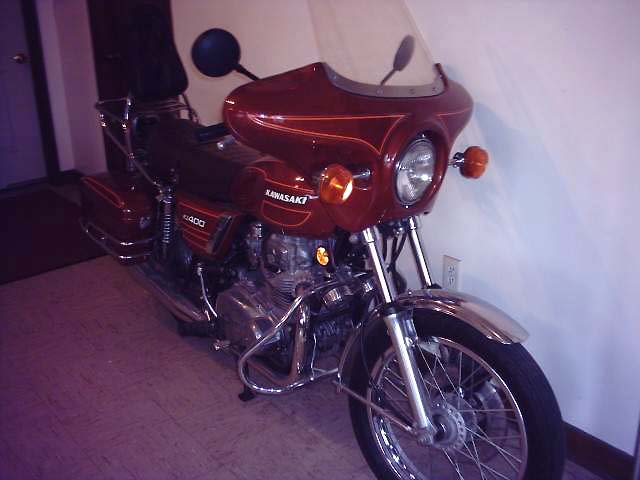
An unrestored 1978 KZ 400 B1
This bike belongs to Greg Schamberg from Forth Wayne, Indiana, USA




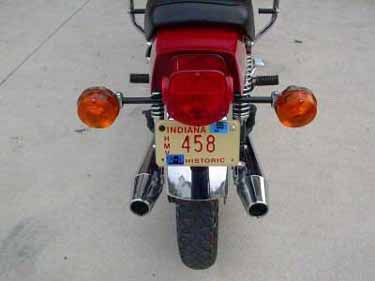

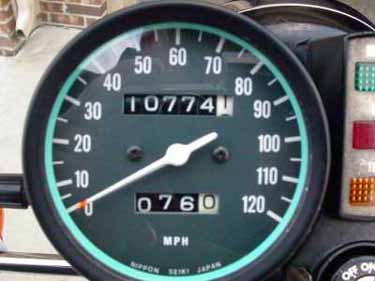





























The 1981 KZ440 A
Pictures used by permission from William Rima from USA.

The 1981 KZ440 B2

